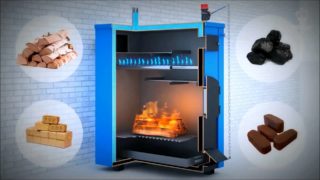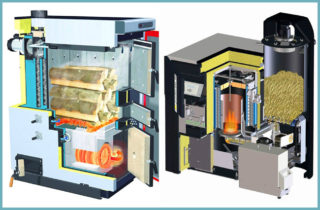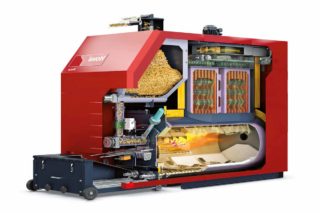The boiler is the main structural element of any heating system. Solid fuel options for heating boilers are a type of heating equipment. With their help, you can organize heating in any room, including an apartment, a private house or a workshop of an industrial enterprise. The constant increase in prices for the main types of fossil energy sources provoked a rather rapid development of solid fuel boilers. It is the efficiency of such equipment that is considered its main advantage. It is achieved due to the low price of consumable fuel.
What are
Combustion conditions
According to the conditions under which fuel combustion occurs, equipment can be divided into the following types:
- Conventional boilers with direct combustion process.
- Boilers with a long combustion cycle.
- Pyrolysis or gas generating.
- Boilers using as fuel processed into fine fraction pellets.
In the usual version of a solid fuel boiler, combustion takes place in a firebox. In addition to ordinary firewood, you can use any type of solid fuel - coal, peat, etc. The combustion products give off thermal energy to the heat exchanger, which transfers it to the coolant into the heating system. Of the main advantages of this boiler option, it is worth noting the simplicity of the design. Fuel combustion occurs within 2-6 hours.
Long burning process
In boilers with a long combustion cycle, it is possible to adjust the power. This is achieved by adjusting the air supply to the sealed combustion chamber. Of the main disadvantages, it is worth noting the exactingness to the quality of fuel. The percentage of its moisture content should not exceed 30%. The best option is considered to be a humidity of 15 - 20%.
Pyrolysis options for solid fuel boilers
Such equipment is produced in two versions - with the upper location of the combustion chamber of gases and with the lower one. Structures with a lower location of the afterburner can be found much more often than their counterparts with an upper location of the firebox. With the upper location of the firewood chamber, it is quite convenient to load fuel. Since the movement of combustion products is not natural, that is, - from top to bottom - the thrust is carried out in a compulsory manner. Thus, the design provides for the presence of a fan.
Solid fuel boilers for pellets
Pellets compressed under pressure acquire a slightly higher density than the raw materials from which they were made. Thus, the specific combustion density is increased. Boilers that use fine granules as fuel have design features. The main structural elements are:
- Receiving hopper.
- Mechanism for feeding pellets into the combustion zone.
- Burner.
- Automatic ignition device.
- Control mechanism with temperature sensors.
In the design of solid fuel pellet boilers, two types of burners are used - flare and retort. In a torch type burner, the combustion of pellets occurs due to the forced air flow, which forms the flame torch. Retort burners are a volumetric bowl made of heat-resistant steel or cast iron. Pellets are mechanically fed through the center of such a bowl. Burning occurs over the entire surface of the bowl.
Each of the types has certain advantages and disadvantages. Thus, flare burners are simpler in terms of design. The advantages include non-exactingness to the quality of the pellets. The retort type burners are characterized by higher power and higher efficiency. However, burners of this type are more demanding on the quality of fuel pellets.
Main development trends
These tendencies can be safely attributed to the automation of the combustion process. The very process of burning solid fuel is quite difficult to stop. Therefore, situations often arise when the energy output of the boiler does not meet the needs. That is, such equipment is not intended for short-term operation. This drawback can be eliminated by installing a buffer tank in the heating system. It performs the function of accumulating thermal energy with its subsequent transfer to the heating system.
Models of solid fuel boilers, which are produced by modern industry, represent a worthy alternative to equipment that uses gas, electricity, and diesel fuel as fuel. In the designs of modern solid fuel boilers, innovative technologies are used that significantly increase their competitiveness in the heating equipment market.











